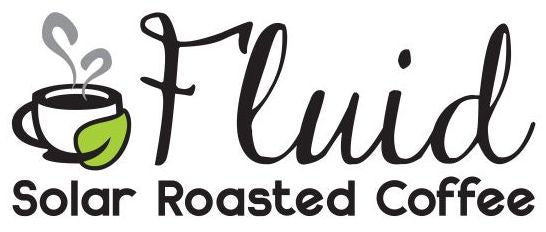A Tour of our Renewable Energy Systems
Quite a few people have asked about the "Solar" in our name, wondering if we somehow roast the coffee in the sunlight, or have some big sun-heated oven. Others wonder what it is like to live off-the-grid "without electricity". This little overview should help put things in order.
There are actually two separate power systems; one to run our house, and a second to power the Fluid Coffee Roastery.
Overview:

Aerial View of Off-the-Grid Home and Coffee Roastery
In this aerial view, our house is in the back center. It is super-insulated and is aligned solar-south to maximize heat from the winter sun and minimize it during the summer. Solar-thermal vacuum tube "panels" are located on the roof and provide a large portion of our hot water requirements. A very clean-burning catalytic wood stove provides space heat and additional hot water during the winter months when the solar thermal system is not fully functional.
There are two small photo-electric panels mounted on sun-following trackers which are located in the center of the picture. A wind turbine in located at the top left of the image. These photo-electric panels and the wind turbine provide electric power to the house.
The large solar panels mounted on the horse stable roof provide 100% of the electricity used to roast our coffee and charge the battery-powered car we use to deliver coffee.
The coffee roastery is located in the courtyard top right and you can also see the Chevrolet Bolt electric car parked there.
Off-the-Grid - Home Power:

There are 2 sets of photoelectric (PV) panels on trackers that follow the sun from east to west each day, returning east just after sundown ready to catch the next mornings' sun. These 26 year old panels are just out of warranty and still going 100% strong!
Wind Turbine and Internet Antennas
The wind turbine does most of its work during the winter and spring months when the weather is darker. Naturally, dark and stormy weather go together, allowing the wind turbine to make up for what the winter sun and solar panels cannot.
We rent space on the wind turbine tower to an Internet company. The Internet repeater radios are powered by the green energy from our solar/wind system. They receive a signal from a main transmitter and our antennas re-broadcast the signal to homes within a 5 km radius.
To put things in prospective, the tower is 100 feet high (~30 m) and the turbine blades are 18 feet (~5.5 m) in diameter.
Electricity from the PV panels and wind turbine is stored in the battery bank shown above. This bank sits in a small closet. Without any wind or sunlight there is enough power to run the house for approximately 1 week.
Finally, electricity from the battery bank feeds power to the inverter bank shown below. The inverter converts the battery power to regular household electricity to feed the lights and appliances.
The Inverter Converts Battery Power to Household Electricity
Over the last 26 years, we have never been without electricity. Our grid-supplied neighbours however, have accumulated many weeks of power outages due to the large ice storms in 1998 and 2018, to mention a few examples.
The Coffee Roasting and Electric Car Power System:
To power the coffee roastery and charge our electric car, we capture sunlight with an array of photo-voltaic (PV) panels mounted on the horse stable roof, which can be seen in the aerial picture, above. We produce quite a bit of electricity actually. In fact, it takes about 11 minutes of sunlight for us to roast 8 pounds of coffee, enough to roast about 1 metric ton per week at full capacity and still leave plenty of energy to charge our electric coffee delivery vehicle.
Even our Fully Electric Car is Charged with Solar Electricity.
We use a Chevrolet Bolt EV - a fully electric vehicle to deliver our coffee. This amazing vehicle has a range of approximately 400 km. Charging takes about 5 seconds to insert the power plug. Charging is done automatically when power rates are lowest (the vehicle knows all of this). When you are ready to leave, the car is already warm (or cooled), seats and steering wheel heated and windows defrosted before you get in. First scheduled service is at 240,000 km or 10 years, with each subsequent service at a further 240,000 km or 10 years! Best of all, even if you have to pay for your electricity, you will spend around $500 per 20,000 km of driving.

The Fully Electric Chevrolet Bolt
During the design phase of our coffee PV system, Ian and Jessie (from our shipping department) carefully inspect a solar pathfinder device, which tracks the location of the sun through the sky. They want to make sure that the solar array is not shaded by obstructions such as tree limbs or other buildings. Jessie approves our location.
The panels are installed on mounting rails attached to the horse barn roof. The total array is capable of generating 10,000 watts, more than enough to power the Fluid Coffee roasting system. There are a total of 48 panels installed measuring approximately 37 x 12 feet (~11 x 4 m).
The electrical power from the PV array is converted into "regular" A.C. power which is in turn connected to the electrical grid and the coffee roastery. Excess electricity is "stored" on the Ontario Hydro power grid and purchased back, during the night or on cloudy days. The system generates about 2 times more power than is currently required to roast our delicious coffee and charge the electric vehicle.








